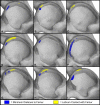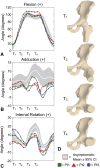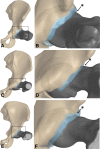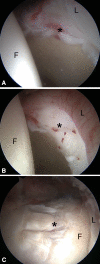Subject-specific patterns of femur-labrum contact are complex and vary in asymptomatic hips and hips with femoroacetabular impingement
- PMID: 25193693
- PMCID: PMC4397749
- DOI: 10.1007/s11999-014-3919-9
Subject-specific patterns of femur-labrum contact are complex and vary in asymptomatic hips and hips with femoroacetabular impingement
Abstract
Background: Femoroacetabular impingement (FAI) may constrain hip articulation and cause chondrolabral damage, but to our knowledge, in vivo articulation and femur-labrum contact patterns have not been quantified.
Purpose: In this exploratory study, we describe the use of high-speed dual-fluoroscopy and model-based tracking to dynamically measure in vivo hip articulation and estimate the location of femur-labrum contact in six asymptomatic hips and three hips with FAI during the impingement examination. We asked: (1) Does femur-labrum contact occur at the terminal position of impingement? (2) Could range of motion (ROM) during the impingement examination appear decreased in hips with FAI? (3) Does the location of femur-labrum contact coincide with that of minimum bone-to-bone distance? (4) In the patients with FAI, does the location of femur-labrum contact qualitatively correspond to the location of damage observed intraoperatively?
Methods: High-speed dual-fluoroscopy images were acquired continuously as the impingement examination was performed. CT arthrogram images of all subjects were segmented to generate three-dimensional (3-D) surfaces for the pelvis, femur, and labrum. Model-based tracking of the fluoroscopy images enabled dynamic kinematic observation of the 3-D surfaces. At the terminal position of the examination, the region of minimal bone-to-bone distance was compared with the estimated location of femur-labrum contact. Each patient with FAI underwent hip arthroscopy; the location of femur-labrum contact was compared qualitatively with damage found during surgery. As an exploratory study, statistics were not performed.
Results: Femur-labrum contact was observed in both groups, but patterns of contact were subject-specific. At the terminal position of the impingement examination, internal rotation and adduction angles for each of the patients with FAI were less than the 95% confidence intervals (CIs) for the asymptomatic control subjects. The location of minimum bone-to-bone distance agreed with the region of femur-labrum contact in two of nine hips. The locations of chondrolabral damage identified during surgery qualitatively coincided with the region of femur-labrum contact.
Conclusions: Dual-fluoroscopy and model-based tracking provided the ability to assess hip kinematics in vivo during the entire impingement examination. The high variability in observed labrum-femur contact patterns at the terminal position of the examination provides evidence that subtle anatomic features could dictate underlying hip biomechanics. Although femur-labrum contact occurs in asymptomatic and symptomatic hips at the terminal position of the impingement examination, contact may occur at reduced adduction and internal rotation in patients with FAI. Use of minimum bone-to-bone distance may not appropriately identify the region of femur-labrum contact. Additional research, using a larger cohort and appropriate statistical tests, is required to confirm the findings of this exploratory study.
Figures






Comment in
-
CORR Insights: Subject-specific patterns of femur-labrum contact are complex and vary in asymptomatic hips and hips with femoroacetabular impingement.Clin Orthop Relat Res. 2014 Dec;472(12):3923-5. doi: 10.1007/s11999-014-3988-9. Epub 2014 Oct 8. Clin Orthop Relat Res. 2014. PMID: 25293496 Free PMC article. No abstract available.
Similar articles
-
Femoroacetabular Impingement Patients With Decreased Femoral Version Have Different Impingement Locations and Intra- and Extraarticular Anterior Subspine FAI on 3D-CT-Based Impingement Simulation: Implications for Hip Arthroscopy.Am J Sports Med. 2019 Nov;47(13):3120-3132. doi: 10.1177/0363546519873666. Epub 2019 Sep 20. Am J Sports Med. 2019. PMID: 31539275
-
In-vivo hip arthrokinematics during supine clinical exams: Application to the study of femoroacetabular impingement.J Biomech. 2015 Aug 20;48(11):2879-86. doi: 10.1016/j.jbiomech.2015.04.022. Epub 2015 Apr 22. J Biomech. 2015. PMID: 25997726 Free PMC article.
-
What MRI Findings Predict Failure 10 Years After Surgery for Femoroacetabular Impingement?Clin Orthop Relat Res. 2017 Apr;475(4):1192-1207. doi: 10.1007/s11999-016-5040-8. Clin Orthop Relat Res. 2017. PMID: 27580735 Free PMC article.
-
Beyond the Scope Open Treatment of Femoroacetabular Impingement.Bull Hosp Jt Dis (2013). 2018 Mar;76(1):47-54. Bull Hosp Jt Dis (2013). 2018. PMID: 29537957 Review.
-
[Torsional deformities of the femur in patients with femoroacetabular impingement : Dynamic 3D impingement simulation can be helpful for the planning of surgical hip dislocation and hip arthroscopy].Orthopade. 2020 Jun;49(6):471-481. doi: 10.1007/s00132-019-03847-x. Orthopade. 2020. PMID: 31853580 Review. German.
Cited by
-
In Vivo Pelvic and Hip Joint Kinematics in Patients With Cam Femoroacetabular Impingement Syndrome: A Dual Fluoroscopy Study.J Orthop Res. 2020 Apr;38(4):823-833. doi: 10.1002/jor.24509. Epub 2019 Nov 14. J Orthop Res. 2020. PMID: 31693209 Free PMC article.
-
In Vivo Quantification of Hip Arthrokinematics during Dynamic Weight-bearing Activities using Dual Fluoroscopy.J Vis Exp. 2021 Jul 2;(173):10.3791/62792. doi: 10.3791/62792. J Vis Exp. 2021. PMID: 34279514 Free PMC article.
-
Revisiting the Anteroinferior Iliac Spine: Is the Subspine Pathologic? A Clinical and Radiographic Evaluation.Clin Orthop Relat Res. 2018 Jul;476(7):1494-1502. doi: 10.1097/01.blo.0000533626.25502.e1. Clin Orthop Relat Res. 2018. PMID: 29794857 Free PMC article.
-
Reliability of hip range of motion measurement among experienced arthroscopic hip preservation surgeons.J Hip Preserv Surg. 2019 Dec 12;7(1):77-84. doi: 10.1093/jhps/hnz062. eCollection 2020 Jan. J Hip Preserv Surg. 2019. PMID: 32382433 Free PMC article.
-
Quantitative comparison of cortical bone thickness using correspondence-based shape modeling in patients with cam femoroacetabular impingement.J Orthop Res. 2017 Aug;35(8):1743-1753. doi: 10.1002/jor.23468. Epub 2016 Nov 8. J Orthop Res. 2017. PMID: 27787917 Free PMC article.
References
-
- Audenaert E, Van Houcke J, Maes B, Vanden Bossche L, Victor J, Pattyn C. Range of motion in femoroacetabular impingement. Acta Orthop Belg. 2012;78:327–332. - PubMed
MeSH terms
LinkOut - more resources
Full Text Sources
Other Literature Sources
Medical
Research Materials

